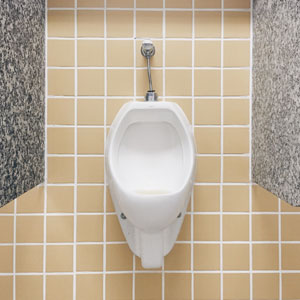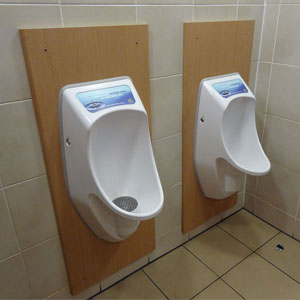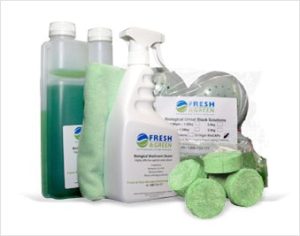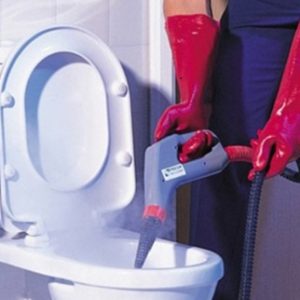Before diving in, we need to understand urine and washroom urinals.
When running a business or a building, sanitation is one of the hot button issues that arise.
It’s not an elegant discussion, but it’s necessary to understand how to manage urinals and washrooms.
After all, knowledge is power.
When you know how things work, you are able to troubleshoot when something goes wrong. Let’s dig in.
Demystifying Urine & Urinals
Understand Urine
-
What Is Urine?
When the kidney flushes out toxins and other waste from your body, it forms urine. Urine consists of 95% water and 5% urea. Urea consists of the waste flushed from your body, and the contents depend on what was in your body.
When you flush with fresh water in the toilet or urinal, it causes the urea to hydrolyse. The hydrolysis of urea is the cause of any odour you may experience from urine. It takes place when the enzyme urease turns urea into ammonia and carbamate. Carbamate further decomposes to carbonic acid and forms the second molecule of ammonia.
-
Why Does It Smell?
The normal human detection of ammonia is estimated to be 50 parts per million (ppm), but some people can detect it at 20 ppm. Ammonia is a colourless but pungent gas. A buildup of hydrolysed urine causes a buildup of odour.
Another major cause of the odour is bacteria that use urine as a food source. The bacteria are present in improperly maintained washrooms. These bacteria feed on urine and penetrate porous surfaces, grout and etched porcelain.
Types of Urinals
-
Flushing Urinals

Photo: Pexels
Any flushing urinal has four basic parts: a urinal bowl, a cistern to hold water, a flushing mechanism, and a trap that carries the contents to the drain. The flushing mechanisms come in different shapes, sizes and technologies.
The most basic flushing system is the manual flush that uses a lever to activate the flush. There are also timed flushing systems that auto-flush at intervals. Sensor flush urinals notice when a person in front of it and will flush once the person steps back.
Properties of flushing urinals include:
- Need Odour Control
Most people complain of odour in flush urinals. Odour control mechanisms like urinal cakes and air fresheners are needed. Odours are created when urine mixes with water and hydrolyses into ammonia. They need frequent cleaning and odour control measures. - Require Frequent Maintenance
Flush toilets need frequent maintenance. The hydraulic flush may break down and an electronic flush needs regular replacement. Cleaning staff might need to regularly check the urinals in case a user chose not to flush. - Clogged up by Hard Water
Where the water used to flush contains minerals (hard water), it deposits sediments on urinal pans and drainage lines. This makes the washrooms smell worse and chokes the drainage line. This racks up an expensive maintenance budget. - Wastes a Lot of Water
With 4-6 litres of water used per flush, urinals use almost 38% of the water in offices and buildings. However, low flush toilets still use a lot of water since they use two litres per flush. A lot of water goes down the drain. Literally.
- Need Odour Control
-
Waterless Urinals

Photo: Common Wikimedia
Waterless urinals are made of the same materials as traditional flushing urinals. They are also plumbed into the standard drain line. However, that’s where the similarities end.
They use a cartridge filled with a liquid sealant that sits atop the drain area of the urinal. The sealant forms a barrier once the urine passes through the trap/cylinder to prevent odour. Urine, being denser than the sealant oil, displaces it and flows into the drainpipe.
Properties of the waterless urinal include:
- Maintains Cleanliness
They eliminate splashing of urine to the floors or walls due to their sleek and improved design. Urine is sterile until it mixes with water, which allows the bacteria to develop. - Stays Odour-Free
Since waterless urinals use gravity to draw urine to the drain, it prevents the need for water. The sealant in the trap acts as a barrier between the urine and atmosphere, preventing odour. It also prevents sewer gases from the drain escaping to the restroom air. - Stress-Free Maintenance
The only initial cost lies in installation and training cleaning staff on how waterless urinals work. Afterwards, maintenance costs remain low. Flashing urinals have many moving parts that get jammed or vandalised. Waterless urinals have no moving parts. - Water Savings
A traditional flushing urinal uses 4-6 litres of water per flush. Even a low flush toilet uses up to 2 litres of water with each flush. This adds up to about 1-3 gallons per flush and 40,000 gallons annually. If you convert all that into your area’s water costs, you see how much water a waterless urinal saves.
- Maintains Cleanliness
Why Do Urinals Stink?
-
Poor Ventilation
Bacteria thrive in warm environments. When the washroom gets too warm, odour-causing bacteria multiply faster. In flushing urinals, the heat causes faster ammonia production by speeding up the uric acid reaction. When the drain pipes are in direct contact with hot gas exhaust lines, it evaporates the drain fluids and creates more smells.
-
Ammonia Levels
The smell in most restrooms comes from urine spilt on areas next to the urinal. When urinals are not optimised to drain all the urine, splashing urine around leads to a foul smell, especially in high traffic areas. The spilt urine hosts bacteria that feed on the waste in the urine and produce foul gases.
-
Poor Urinal Installation
In flushing urinals, faults in installing the drain pipe cause odour. This is because the smells are released back into the restroom atmosphere. The recommended solution is using a drain trap, cockroach trap or Nani trap that creates a barrier for gases. It also prevents cockroach or rat infestation.
In waterless urinals, odours are only caused by bad installation or maintenance. If the sealant liquid in the cylinder does not rest well on the drain entrance, it could allow gases to seep into the restroom atmosphere.
-
Poor Plumbing Design
How are the pipes and outlets connected in the washroom? For instance, if the overflow pipe from a WC cistern is connected to a urinal, smells come up from the waste into the cistern and out into the washroom.
Configure exhaust systems to keep positive ventilation. Ensure doors and windows have louvres where fresh air is pulled in to regulate airflow.
-
Poor Cleaning
In flushing urinals, observe the standard cleaning process to prevent odour. The smell is caused by the formation of algae, debris and scaling. This generates foul-smelling organisms, salt formation, and in longer runs, ammonia build-up.
For waterless urinals, the odour can be caused by improper cleaning. Water-based cleaning agents react with the sealant and prevent it from working. Frequent cleaning with a biochemical spray and a cloth will keep the urinal fresh. Clean more often for high-usage areas.
-
Spills on the Floor
When urine spills to the floor or walls, it leads to odour since bacteria feed on the urine and produce foul gases. This is why the good design of urinals is essential to preventing spills. You should also ensure that your cleaning team reaches every area in a restroom.
How to Care for Urinals
For flushing urinals, ensure daily cleaning and use of scented cleaning solutions. Consider using urinal cakes for odour control as well. Keep a thorough maintenance schedule and call your plumber for regular upkeep.
It is possible to have waterless urinals produce odour. The reason is always the same: they’re not cleaned properly. When you are aware of how waterless urinals work, you can ensure they stay odour-free.
How to Ensure Waterless Urinals Don’t Smell

Maintain the level of hygiene with Alsco Biological Treatment
-
Use Proper Cleaning Agents
For effective daily cleaning, using the correct cleaning solutions goes a long way. Biological treatment is a game-changing way to clean. It uses harmless “bugs” that consume bacteria and other germs without damaging the washroom surfaces.
If used regularly, it forms a permanent protective layer on the surface being cleaned. This helps to further ensure that the area stays clean and odour-free between cleans. Toxic chemicals can work as a one-time solution but are not friendly.
With daily cleaning in place, remember that regular cleaning still leaves something behind. This is why it’s important to schedule systematic cleaning, also known as deep cleaning.
Use a reputable supplier with powerful chemicals and high-tech equipment. Alsco’s deep cleaning service offers just what you need. Clean every little detail of your washroom, down to every single tile.
A good supplier will provide services and cleaning solutions that they replace regularly. Alsco NZ supplies biological treatment and blocks that maintain the work done by the deep cleaners.
-
Train Your Staff on How to Handle Waterless Urinals
To create a training program or guide, it’s good to know the basics of how to clean the waterless urinal. There are some differences depending on the manufacturer but the common steps are as below:
- Put on gloves (and goggles) to prepare for cleaning the restroom.
- Remove all foreign objects blocked by the trap. It is designed to prevent larger objects from entering the drain area.
- Stay away from abrasive cleaners, towels, or brushes.
- Spray the urinal surfaces with a neutral or all-purpose cleaner. For best practices, use biological treatments.
- Allow the solution to sit for a while if indicated by the chemical manufacturer.
- Use a soft cloth or sponge to wipe the surfaces clean.
- Use a dry cloth to finish and dry the surfaces.
Your staff also needs to be instructed on how to replace the parts that need to be changed. Keep a maintenance schedule that ensures parts are replaced in good time. It is important to train them to do it properly. The parts that need to be replaced include the cylinder and sealant liquid
-
Never Put Water Down Waterless Urinals
The water will affect the effectiveness of the sealant and create a limestone deposit in the drain pipes. When the calcium in water comes into contact with uric acid, it forms limestone that blocks the pipes.
When changing the cylinder and cleaning the drainpipe, pour water through the drainpipe to remove limestone build-up. Water is fine for occasional flushing of the drain pipe, but it should never be used in the waterless urinal cylinder.
What’s Next?
When you invest in waterless urinals, invest in the training and education that equips your staff to care for them correctly.
With the right cleaning and maintenance, they will never smell! The cleaning regimen is simple, as it only needs a biological treatment and a cloth.
Remember to also schedule deep cleaning from experts who will thoroughly clean every corner of the washroom. It is important to safeguard the health and safety of your staff and colleagues.
The right supplier will make sure maintenance is a breeze. Choose an affordable but reliable partner like Alsco NZ.
Photo: 4045



